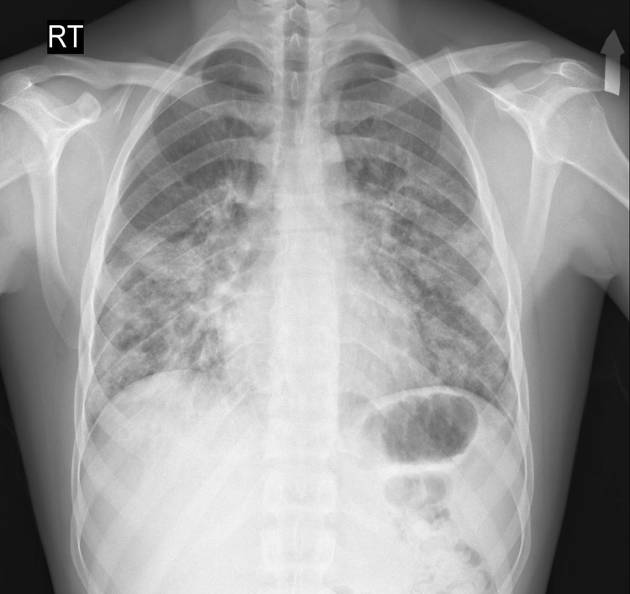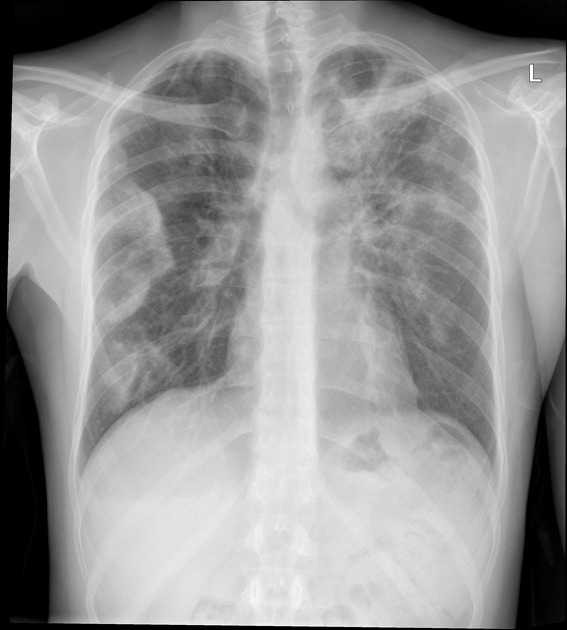Eosinophilic pneumonia chest x ray: Difference between revisions
Jump to navigation
Jump to search
No edit summary |
No edit summary |
||
| Line 18: | Line 18: | ||
*ill-defined centrilobular nodules: present in around one-third of cases | *ill-defined centrilobular nodules: present in around one-third of cases | ||
[[File:75fb7cd80d5ca4074c474f93471ad4 big gallery.jpeg|300px|center|Acute eosinophilic pneumonia x-ray, source: Case courtesy of Dr Yair Glick, Radiopaedia.org, rID: 53840]] | |||
[[File:22ebbc464e16ea1217228e3c9f4935 big gallery.jpeg|300px|center|Chronic eosinophilic pneumonia, source: Case courtesy of Dr Henry Knipe, Radiopaedia.org, rID: 39331]] | |||
Case courtesy of Dr Henry Knipe, Radiopaedia.org, rID: 39331 | |||
==References== | ==References== | ||
{{reflist|2}} | {{reflist|2}} | ||
{{WH}} | {{WH}} | ||
{{WS}} | {{WS}} | ||
Revision as of 19:00, 13 February 2018
|
Eosinophilic pneumonia Microchapters |
|
Diagnosis |
|
Treatment |
|
Case Studies |
|
Eosinophilic pneumonia chest x ray On the Web |
|
American Roentgen Ray Society Images of Eosinophilic pneumonia chest x ray |
|
Risk calculators and risk factors for Eosinophilic pneumonia chest x ray |
Editor-In-Chief: C. Michael Gibson, M.S., M.D. [1]
Overview
Chest X Ray
- At the onset of AEP, the chest radiograph may show only subtle reticular or ground glass opacities, often with Kerley B lines. [58,59]
- As the disease progresses, bilateral diffuse mixed ground glass and reticular opacities develop [1,2,9,39-42,59] (image 1A-B).
- Isolated ground glass (approximately 25 percent of cases) or reticular (approximately 25 percent of cases) opacities may also be seen on presentation. The distribution of opacities in AEP is diffuse, unlike chronic eosinophilic pneumonia, in which the opacities are typically localized to the lung periphery.
- Small pleural effusions are common (noted in up to 70 percent of patients) and are frequently bilateral [8,45,48].
- High resolution computed tomography (HRCT) scans are not essential to the diagnosis, but can help characterize the distribution of opacities and guide selection of an area of involvement for bronchoalveolar lavage. The HRCT is always abnormal in patients with AEP and is characterized by bilateral, random, and patchy ground-glass or reticular opacities (image 2) [19,60]. Centrilobular nodules and air-space consolidation are seen in approximately 50 and 40 percent, respectively [19].
- In mild cases, the lesions are sparse or localized [41,61]. At the height of the disease process, HRCT reveals ground-glass opacities along the bronchovascular bundles. Pleural effusions, usually bilateral, are present in almost 90 percent.
- bilateral ground-glass areas: common
- interlobular septal thickening: common
- pleural effusions: can be present in ~80% (range 60-100%) of cases
- thickening of bronchovascular bundles: present in around two-thirds of cases
- air-space consolidation: present in around half of cases
- ill-defined centrilobular nodules: present in around one-third of cases

